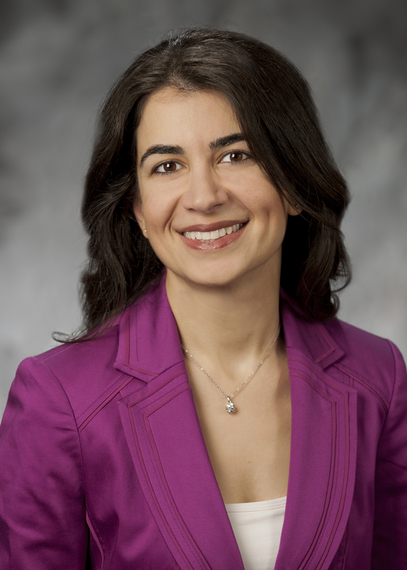With the goal of harnessing the untapped potential of Iranian-Americans, and to build the capacity of the Iranian diaspora in effecting positive change in the U.S. and around the world, the West Asia Council has launched a series of interviews that explore the personal and professional backgrounds of prominent Iranian-Americans who have made seminal contributions to their fields of endeavour. We examine lives and journeys that have led to significant achievements in the worlds of science, technology, finance, medicine, law, the arts and numerous other endeavors. Our latest interviewee is Yasamin Mostofi.
Yasamin Mostofi is an associate professor in the Department of Electrical and Computer Engineering at the University of California Santa Barbara, where she runs a research lab on mobile sensor networks. Yasamin is the recipient of the 2011 Presidential Early Career Award for Scientists and Engineers (PECASE) from President Obama, the National Science Foundation (NSF) CAREER award, and the IEEE 2012 Outstanding Engineer Award of Region 6, which includes more than 10 Western U.S. states, among other awards.
Yasamin's research is multidisciplinary. Her current research thrusts include RF sensing, X-ray vision for robots, see-through imaging, occupancy estimation, communication-aware robotics, and human-robot networks. For more details, please click (here).
You were born and raised in Tehran. Please tell us about where you attended school.
I did all my schooling in Iran until graduate school, for which I came to the United States to go to Stanford University. I have always been very passionate about mathematics from early on. So, I did my undergraduate in Electrical Engineering at Sharif University of Technology, which is a great school and the best technical university in Iran. However, becoming an engineer is not something that was valued as high as becoming a medical doctor in Iran. So, I had to fight hard at times to convince my family (of mainly medical doctors) that engineering was as promising a career, especially for a girl. Thankfully, I was quite stubborn.
You have been awarded the highly prestigious Presidential Early Career Award for Scientists and Engineers (PECASE). What are your most significant accomplishments that brought you to this point?
I am honored to have received the Presidential Early Career Award for Scientists and Engineers (PECASE) from President Obama in 2011. Every year, about 80 to 100 young scientists are chosen to receive this award in the United States. I received the award for my proposed multi-disciplinary methodology for sensing, communication, and navigation of a team of unmanned vehicles. On the sensing and navigation side, I proposed new non-traditional ways of sensing and learning the environment with minimal information. Here are a few examples. Imagine unmanned vehicles arriving behind thick concrete walls. They have no prior knowledge of the area behind these walls. But they are able to see every square inch of the invisible area through the walls, fully discovering what is on the other side with high accuracy. Now, imagine robots doing all these with WiFi RSSI signals (WiFi signal strength measurements) and no other sensors, leveraging their mobility to design and traverse paths most informative for see-through imaging. In another example, consider a typical WiFi link that connects a laptop to a router. Can this link use its received RSSI measurements and count the number of people walking in an area, without relying on people to carry any electronic device? Proposing methodologies for accomplishing these kinds of non-traditional sensing methods contributed to receiving this award. My lab has also demonstrated their successful performance. This is important as Radio Frequency (RF) signals, such as WiFi, are everywhere these days and they can carry a considerable amount of information about their surroundings as they interact with them. Here, our goal is to understand the fundamentals of sensing with everyday RF signals and the implication of using robotic units for an automated and optimized way of RF sensing. I have been very excited about this research in the past few years.
As another part of the award, I have further proposed communication-aware navigation approaches to enable successful cooperative operation of a robotic network. We will talk about this part more in the next items.
Your work on using WiFi signals for sensing, imaging, and occupancy estimation has been in the news a few times over the past couple of years. Can you tell us about some of the applications of this work?
Consider occupancy estimation with WiFi signals. There are several potential applications that can benefit from an estimation of how crowded an area is. For instance, heating and cooling of a building can be better optimized based on learning the concentration of the people over the building. Emergency evacuation can also benefit from an estimation of the level of occupancy. Stores can also benefit from counting the number of shoppers for a better business planning. Another good application is smart cities, which is a new initiative towards a more optimized planning of the resources in a city. In this context, the ability to estimate the crowded areas can help considerably with a better planning of limited resources. Given that WiFi signals are everywhere these days, we envision them as a new tool for occupancy estimation, with the advantage of preserving privacy as compared to cameras. Using WiFi signals for occupancy estimation further creates the potential for counting behind walls.
Our work on x-ray vision for robots with WiFi signals also creates new possibilities in terms of applications. For instance, imagine a search and rescue operation after an earthquake. The ability to see through walls would allow the humans/robots outside to assess the situation inside the building before entering it. Furthermore, the automation through utilizing robots would allow the operation to take place in areas hazardous to humans. Another good application is an archaeological discovery. Having a non-invasive approach to see details through blocking objects, without a need to dig, can be very useful in archeological explorations.
In another line of work, you have used the term "communication-aware control and motion planning" to describe some of your research. Can you tell our readers what this area is about? Can you also tell us about other related projects i.e., Co-optimization of Motion, Communication and Sensing under Resource, Human-Robot Networks, or Understanding Wireless Channel Spatial Predictability for Connectivity Optimization in Robotic Networks?
This work is on enabling the successful cooperative operation of a team of unmanned vehicles. Imagine you give a group of robots a task to do cooperatively. For instance, we may put a team of unmanned vehicles in charge of a search and rescue operation in the future. The team has to do the task in a cooperative manner. Thus, maintaining a proper connectivity is crucial to the success of the operation. In order to enable this, we need to jointly look at the communication and robotic issues as they become intertwined. For instance, certain robotic paths can result in a better connectivity. Communication-aware robotics is a term we use to describe a multi-disciplinary approach to robotic networks, where we co-optimize connectivity and path planning of a team of unmanned vehicles, building on my background in both areas. This is a very exciting and challenging research area where realistic communication models should be incorporated in the optimization of robotic sensing and path planning. Our work on understanding the spatial predictability of communication channels is one component of this co-optimization approach.
The fact that the robots have limited on-board energy further makes the overall design challenging. For instance, should a robot incur motion energy to move to a place better for connectivity or should it simply increase its communication power and shout louder to be heard by its teammates? How should the robots plan their trajectories such that they can sense and gather as much information as possible from the environment under their limited energy budget? Our research is aimed at answering such questions by fundamentally understanding the underlying tradeoffs and properly optimizing the operation of a team of unmanned vehicles under resource constraints.
Based on your research interests: decision making in robotic networks, x-ray vision for robots, cooperative information processing, compressive sensing and control, obstacle mapping, and robotic routers. How we get robots to think for themselves?
It is an exciting time for robotics and artificial intelligence these days, as we see from many startups and companies that are working in related areas. The idea of driving Google's automated car or getting our packages dropped off by Amazon's unmanned air vehicles are not too far-fetched anymore. My work is on the decision making, sensing, and communication aspects of the robots. With more powerful processors on board, and smaller robotic platforms available, we can develop advanced algorithms that enable robotic group decision making, getting us closer to the vision of unmanned vehicles becoming part of our everyday society soon. In my group, for instance, we have shown how robots can efficiently work with humans by predicting humans responses and behaviors. In terms of sensing, equipping robots with better sensing capabilities, through both hardware design and smarter processing, can allow them to develop a better understanding of their surroundings. Along this line, our aforementioned work on x-ray vision with WiFi, for instance, allows the robots to image details through walls with simple WiFi signals. In terms of communication and group behavior, our communication-aware robotics work then allows the robots to smartly maintain their needed connectivity while accomplishing a group task.
How different the US education system is vs. Iran educational system?
I would say there is more emphasis on theory than practice in Iran. A typical high school education, for instance, would involve taking several advanced subjects in mathematics in Iran, which can give the students a very solid background. However, my high school did not offer a single lab class. On the other hand, American education better fosters creativity and leadership through hands-on projects and group activities.
Another difference is in the admission process to the universities. In Iran, there are many interested students and only a few good universities. Therefore, there is a national exam that all graduating high school seniors in the country take on a specific time and date. It is your rank in that exam that not only decides which university you will attend but what field you will study. In the United States, students have more options in terms of universities. Therefore, as long as they study well in their high school, they can typically pursue their field of interest.
How do you compare the presence of female students in engineering fields in US and Iran?
Interestingly, the percentage of female students is pretty similar in the universities in Iran and US. Furthermore, the ratio of female and male students entering universities in Iran, considering all the fields and not just engineering, is pretty balanced. However, female students are still fairly under-represented in science and engineering fields worldwide, something that I hope to see change drastically in my lifetime.

